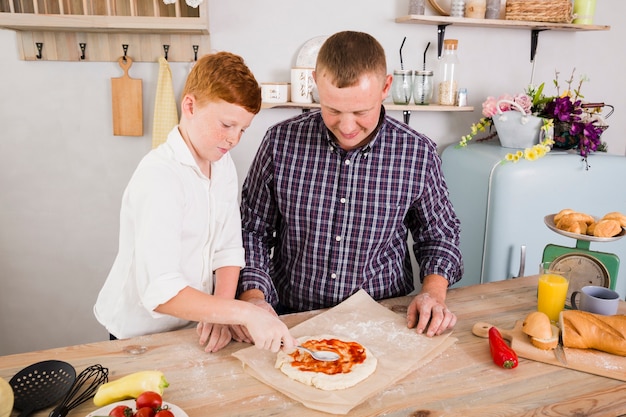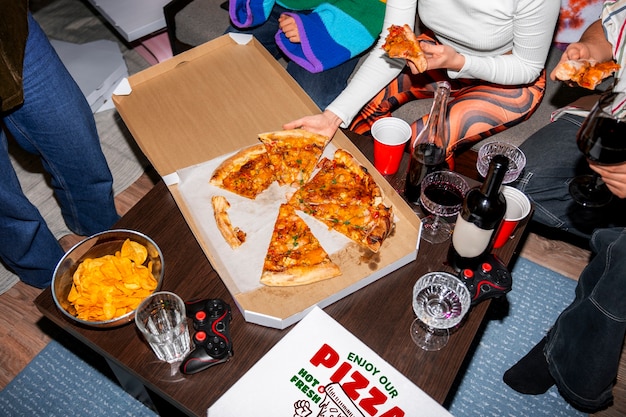The aroma of freshly baked pizza, that irresistible combination of yeasty dough, bubbling cheese, and tangy sauce – it's a sensory experience that transports us to a place of pure culinary bliss. But achieving that perfect pizza, with its crispy crust, bubbly cheese, and perfectly cooked toppings, requires more than just throwing ingredients together. It's about understanding the art and science of baking, particularly when it comes to nailing the baking time.
I've been on a lifelong pizza quest, and I've learned that the journey to pizza perfection is paved with trial and error. I've had my fair share of pizza disasters, from undercooked doughy messes to overcooked burnt crusts. But, through these culinary mishaps, I've learned a thing or two about baking time, and I'm here to share my wisdom, to help you avoid those pizza pitfalls and create a pie that's worthy of a standing ovation.
Part 1: The Factors Influencing Pizza Baking Time

The question "How long do I bake my pizza?" doesn't have a one-size-fits-all answer. There are a few crucial factors that influence baking time, like the ingredients in a recipe, each contributing to the final outcome. Let's break down these factors, so you can bake with confidence.
1. The Oven: The Heart of the Operation
Imagine your oven as the heart of your pizza-baking operation. It's the source of the heat that transforms raw dough into a golden-brown masterpiece. The temperature of your oven plays a critical role in determining the baking time.
Think of it this way: a hotter oven will cook your pizza faster. A pizza baked in a 500°F (260°C) oven will need less time than one baked in a 450°F (232°C) oven. The hotter oven will also create a crispier crust, due to the intense heat.
But here's the catch: every oven has its own personality. Some run hot, others run cold. Some maintain a consistent temperature, while others fluctuate wildly. The only way to know your oven's quirks is to experiment, to become familiar with its temperament.
2. The Pizza: The Star of the Show
Now, let's talk about the pizza itself, the star of the show. The size, thickness, and toppings of your pizza all impact baking time. A large pizza, like a grand stage, will take longer to cook than a small pizza, while a thick crust, like a hefty script, needs more time than a thin crust.
And even the toppings you choose, the actors in our culinary drama, can influence the baking time. Pizzas with lots of moisture-laden toppings, like mushrooms, peppers, and spinach, will take longer to cook because the extra moisture needs time to evaporate. So, consider the moisture content of your toppings when planning your baking time.
3. The Baking Stone: The Unsung Hero
Let's not forget about the baking stone, the unsung hero of pizza-making. This trusty companion absorbs heat evenly, creating a crisp crust and preventing the pizza from sticking to the bottom of your oven. It's like a seasoned stagehand, ensuring a smooth performance.
If you're using a baking stone, it's crucial to preheat it thoroughly before you place your pizza on it. A preheated baking stone acts like a hot stage, ensuring your pizza cooks evenly and avoids a soggy, disappointing bottom.
Part 2: How to Determine the Perfect Baking Time

We've discussed the factors that influence baking time, now let's talk about how to determine the perfect baking time. It's a combination of observation, experience, and a little bit of pizza intuition.
1. The Visual Test
First, let your eyes be your guide. Observe your pizza. Does the crust look golden brown? Are the cheese bubbles bursting, like excited audience members? Is the sauce bubbling around the edges, creating a symphony of flavors? These are all good signs that your pizza is nearing perfection.
However, visual indicators can be tricky, especially if you're using a dark baking stone. The crust might appear darker than it actually is, so don't rely solely on color. Use your instincts and knowledge of your oven.
2. The Touch Test
Don't be afraid to get your hands a little dirty. Carefully lift a corner of your pizza with a spatula. Does the crust feel firm and cooked through? If it's still soft and pliable, it needs more time. If it's hard and crispy, you're getting close to perfection.
Remember, the center of the pizza is typically the last part to cook, so focus your attention there. Use your fingers to gently press the center. It should feel firm, not soft and doughy.
3. The Temperature Test
For those who prefer a more precise approach, you can use a kitchen thermometer. Insert it into the thickest part of the pizza, avoiding any toppings, and check the temperature. Ideally, you're aiming for an internal temperature of around 200°F (93°C).
However, this method isn't always necessary. Trust your instincts and use the visual and touch tests first. The thermometer is just a handy backup for those who want to be extra sure.
Part 3: Pizza Baking Times for Different Styles

Let’s get specific. The baking time for your pizza will vary depending on the style you choose. Here are some common pizza styles and their approximate baking times. Remember, these are just guidelines, so adjust as needed based on your oven and personal preferences.
1. Thin Crust Pizza
Thin crust pizzas are known for their crispy texture and minimal dough, making them a quick and satisfying choice. They typically bake for a shorter amount of time than thicker crust pizzas.
Here’s a general guideline for thin crust pizzas:
- 450°F (232°C) oven: 10-12 minutes
- 500°F (260°C) oven: 8-10 minutes
2. Deep Dish Pizza
Deep dish pizzas, with their thick crust and generous amount of toppings, require a longer baking time to ensure everything is cooked through.
Here’s a general guideline for deep dish pizzas:
- 425°F (220°C) oven: 25-30 minutes
- 450°F (232°C) oven: 20-25 minutes
3. New York Style Pizza
New York style pizzas, with their large size, thin crust, and floppy slices, have a reputation for being a bit more challenging to bake. But with a few tips and tricks, you can achieve that classic New York style.
Here’s a general guideline for New York style pizzas:
- 450°F (232°C) oven: 15-20 minutes
- 500°F (260°C) oven: 12-15 minutes
Part 4: Pizza Baking Time: Troubleshooting
Every pizza journey comes with challenges. You might encounter a situation where your pizza doesn't quite turn out as planned. Don’t despair, here’s a guide to troubleshoot common pizza-baking problems.
1. Undercooked Crust
An undercooked crust will be soft and doughy, a bit like a deflated balloon. This is a common problem, especially when you're baking a thick crust pizza. The solution is simple: Return the pizza to the oven for a few more minutes.
However, if the crust is already starting to burn, you might need to lower the oven temperature slightly. Remember, you can always add a few more minutes, but you can't take away burned time.
2. Overcooked Crust
An overcooked crust will be dry and hard, a bit like a stale cracker. The culprit? Too much time in the oven. If you catch it early, you can remove the pizza from the oven and let it cool for a few minutes. This can help to soften the crust.
However, if the crust is already very hard, there’s not much you can do. It's a good lesson for next time to keep a watchful eye on your pizza.
3. Soggy Bottom
A soggy bottom is a pizza nightmare. It happens when the crust doesn't have enough time to crisp up. This is often caused by too much moisture in the toppings, or a lack of heat from the baking stone.
To prevent a soggy bottom, preheat your baking stone thoroughly, and be mindful of moisture-laden toppings. You can also use a pizza peel to lift the pizza halfway through baking and rotate it for even cooking.
Part 5: Pizza Baking Time: Tips for Success
You've made it this far, you're well on your way to pizza mastery. Here are some extra tips to help you achieve perfect pizza-baking results.
1. The Importance of Preheating
Preheat your oven to the desired temperature for at least 30 minutes before you start baking. This allows the oven to reach the correct temperature and ensure that your pizza cooks evenly.
Preheating your baking stone is also crucial. Place the baking stone in the oven while it preheats. This will allow the stone to absorb heat and transfer it to your pizza efficiently, resulting in a crispy crust.
2. The Right Pizza Peel
A pizza peel is an essential tool for baking pizza. It allows you to easily slide your pizza onto the baking stone and transfer it to and from the oven, without disturbing the delicate crust.
Choose a peel that's long enough to reach the back of your oven and wide enough to accommodate your pizza. A good pizza peel will have a smooth surface that prevents your pizza from sticking.
3. Don't Overcrowd the Oven
Don't try to bake too many pizzas at once. This can lead to uneven cooking and a less-than-perfect pizza. If you're making multiple pizzas, bake them in batches, allowing enough space between each one.
Think of it as a stage production, each pizza needs its own spotlight to shine.
Part 6: Pizza Baking Time: Experiment and Enjoy
Remember, pizza-making is a journey, a creative exploration. Don’t be afraid to experiment. Try different toppings, crust thickness, and baking times. The more you bake, the better you'll understand the art of pizza-making.
And most importantly, have fun! Enjoy the process and savor the delicious results. Let your passion guide you, and you'll be creating pizza masterpieces in no time.
Part 7: Pizza Baking Time: A Visual Guide
Here's a visual guide to help you visualize the different stages of pizza baking, so you can identify when your pizza is reaching its peak performance.
| Stage | Crust Appearance | Cheese Appearance | Sauce Appearance |
|---|---|---|---|
| Undercooked | Soft and doughy | Slightly melted | Barely bubbling |
| Perfect | Golden brown and crispy | Melted and bubbly | Bubbling and slightly browned |
| Overcooked | Hard and dry | Burnt and dry | Burnt and dry |
Part 8: Pizza Baking Time: FAQs
Here are some frequently asked questions about pizza baking time, with answers to guide you on your pizza-making journey.
1. What if my oven doesn't have a baking stone?
If you don't have a baking stone, you can use a baking sheet. However, the crust may not be as crispy. You can also place a piece of parchment paper on the baking sheet to prevent sticking. But if you're serious about pizza, investing in a baking stone is worth it.
2. How do I know if my pizza is done?
The best way to tell if your pizza is done is to use the visual, touch, and temperature tests. The crust should be golden brown and crispy, the cheese should be melted and bubbly, and the sauce should be bubbling and slightly browned.
3. How long should I preheat my oven?
You should preheat your oven for at least 30 minutes before baking pizza. This will ensure that the oven reaches the correct temperature and the pizza cooks evenly. It's like setting the stage for a perfect performance.
4. What if my pizza is too thin?
If your pizza is too thin, it may cook very quickly. You might need to lower the oven temperature or shorten the baking time. Remember, it’s always better to undercook than overcook.
5. Can I add toppings after baking?
You can add toppings after baking, but they won't be as hot and melty. For the best results, add toppings before baking, so they cook with the pizza and melt beautifully.
Happy pizza-making! I hope these tips and insights help you bake the perfect pie. Remember, it’s all about experimentation, enjoying the journey, and creating pizza that makes your heart sing.
Everyone is watching

Perfect Rice Every Time: The Ultimate Guide to Cooking Rice
Cooking TipsAs a self-proclaimed foodie, I've always been a bit obsessed with rice. It's the foundation of countless cuisi...

Prime Rib Roast Cooking Time Chart: Per Pound Guide
Cooking TipsPrime rib roast. Just the name conjures images of lavish dinners, crackling fires, and hearty laughter. It’s ...

The Ultimate Guide to Cooking Asparagus: Tips, Techniques, and Recipes
Cooking TipsAsparagus. The mere mention of this spring delicacy conjures up images of vibrant green spears, crisp and burs...

Ultimate Guide to Cooking the Perfect Thanksgiving Turkey
Cooking TipsThanksgiving. Just the word conjures up images of overflowing tables laden with delicious food, the scent of r...

How Long to Bake Potatoes in the Oven (Perfect Every Time)
Cooking TipsBaked potatoes are a staple in my kitchen. They're incredibly versatile, delicious, and surprisingly easy to m...
